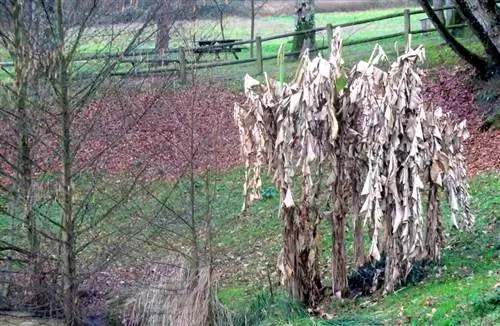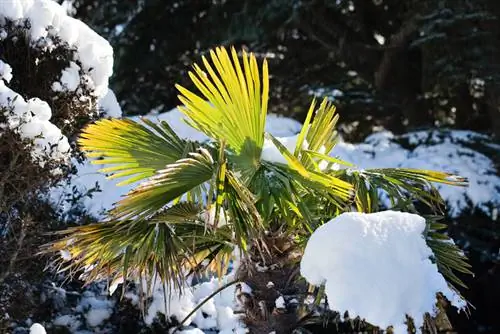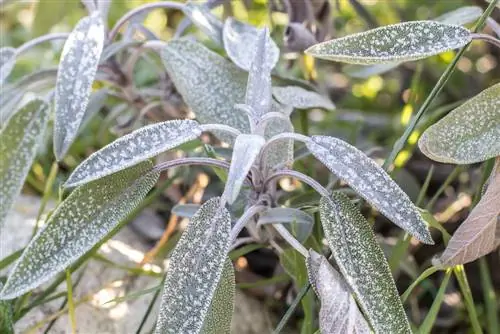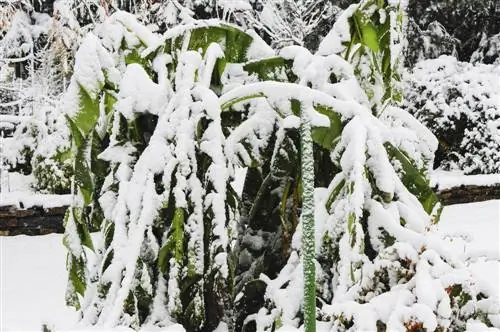- Author admin [email protected].
- Public 2023-12-16 16:46.
- Last modified 2025-01-23 11:20.
Bananas are the declared favorite fruit of many Germans. For several years now, it has also been possible to cultivate a banana tree yourself - either planted in the garden or in a pot. Read how you can keep the exotic plant he althy over the winter.
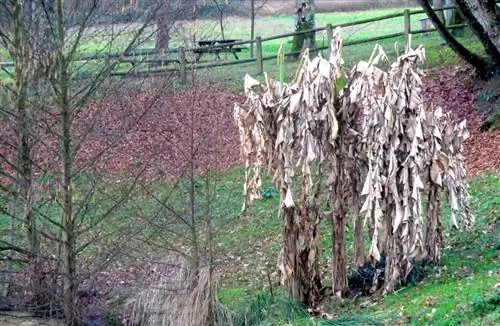
How to overwinter a banana tree?
A hardy banana tree, like the Japanese fiber banana, can overwinter outside if it is protected with leaves and straw and, if necessary, garden fleece. However, tropical banana trees should be overwintered at 5-10 degrees Celsius in a bright, frost-free room.
Can you overwinter the banana tree outside?
In fact, there are some hardy banana trees that can overwinter outdoors. This applies, for example, to the Japanese fiber banana (Musa basjoo). Although this is native to the subtropical climate of East Asia, it is mainly found in the colder altitudes and is therefore relatively tolerant of cold.
These types of bananas are also considered hardy:
- Abyssinian banana (Ensete ventricosum 'Maurelii')
- Darjeeling banana (Musa sikkimensis 'Red Tiger')
- Blue Burmese banana (Musa itinerans 'Burmese Blue')
- Balbis' banana (Musa balbisiana)
- Cheesman banana (Musa cheesmanii)
- Yunnan banana (Musa yunnanensis)
The so-called Indian banana (Asimina triloba) from North America is also hardy, but it is not a banana plant in the true sense.
How much cold can a banana tree tolerate?
But be careful: Even a so-called “hardy” banana tree cannot overwinter outdoors without protection, as the exotic plants can only tolerate a little and/or short-term frost. The species mentioned above have limited frost tolerance in our latitudes and therefore require good winter protection.
The Japanese fiber banana is considered particularly robust and can withstand temperatures of up to minus 10 to 12 degrees Celsius. However, this information only applies to the underground parts of the plant; the leaves freeze at minus three degrees Celsius. However, the plant usually sprouts again.
How do you overwinter non-hardy banana trees?
Tropical banana trees, on the other hand, must under no circumstances overwinter outside; they must spend the cold season frost-free. These species include, for example, the
- Dwarf banana (Musa acuminata)
- Red dwarf banana (Musa uranoscopus)
- Dessert banana (Musa x paradisica)
- Dwarf Dessert Banana (Musa 'Dwarf Cavendish')
These banana plants overwinter best frost-free, but cool at around five to ten degrees Celsius. They need a bright (but not directly sunny!) place because they drop their leaves when there is a lack of light. Winter rest should last from November to April or May.
What steps are necessary to prepare for wintering?
If hardy banana trees are to overwinter outside, cut them back heavily in autumn to just above the ground. Then cover the root area with a thick layer of leaves and straw, over which you can attach polystyrene sheets using tarpaulins. Alternatively, you can also wrap the false trunk with winter-proof packaging (garden fleece (€19.00 on Amazon), which is filled with leaves).
Tropical bananas, on the other hand, are not cut back, but only thinned out when necessary. This involves removing dead or damaged plant parts.
When can the banana tree be taken out of its winter quarters?
From April you can finally free the banana tree from its winter packaging or take it out of its winter quarters. But be careful: Since it can still get very cold at night, the plants still need protection at night or should be brought into the house overnight.
Tip
Can you compost banana leaves?
In fact, banana clippings can be easily composted as long as you chop them up first.

